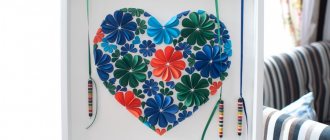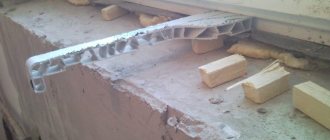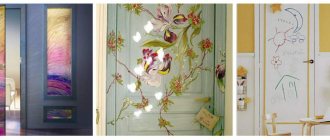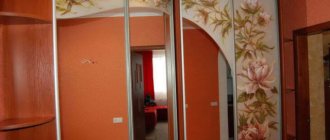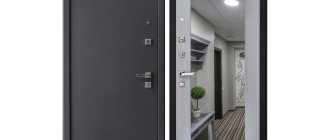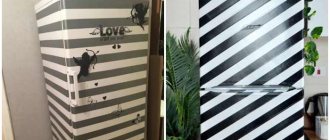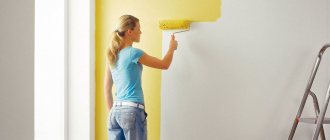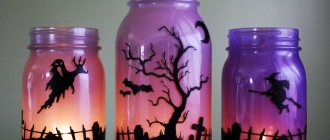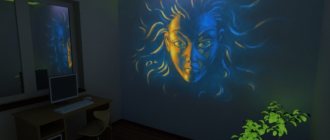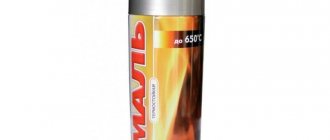Modular decor can be located:
- strictly symmetrical horizontally;
- strictly symmetrical vertically;
- with displacement in different directions.
To change the visual perception of a room, asymmetry is best suited, allowing you to expand, stretch or otherwise adjust the space.
In order for the DIY paintings for the interior, photos of which will later show off in the home album, to be complete, all segments must be at the same distance from each other.
For novice decorators, it is better to choose square modules in the amount of two or three segments and place them horizontally.
What are modular paintings in the interior
Persian carpets were replaced by modular paintings. This is a modern way to decorate the walls of any room, be it the office of a reputable company or a cozy living room in a residential building. Modular paintings differ from ordinary ones in that they are divided into several fragments, which visually merge into a single whole. The range of sizes of individual canvases allows you to fit them into any design. In addition, elements can be shifted vertically and horizontally, and placed with or without symmetry.
Modular paintings on glass are special, the production of which requires special printers and paints. Whichever option you choose, each will perform several functions at once:
- attract the attention of guests;
- create the illusion of movement indoors;
- emphasize refined taste in the interior.
Frame improvements
With the beginning of industrialization and mechanization of production, first lithography techniques appeared, then photography and offset printing, which made it possible to replicate pictures. At the end of the 19th century. Color photography and color offset already existed. Great works of fine art in copies have become available to thousands of people, although not yet to millions. In this regard, inexpensive material for picture frames and a simpler technology for their manufacture were also required.
Profiled slatted frames in the sweatshop conditions of the brutal dawn of capitalism turned out to be unprofitable, because their production required the involvement of expensive skilled labor, which still retained the corporate spirit of medieval workshops. Therefore approx. in the middle of the last century, a baguette was invented in France - a cheap decorative overlay that imitates carved wood and is suitable for mass production by unskilled workers. Perhaps this is where the name comes from: une baguette is the French people's bread. A loaf of baguette with a piece of cheese or dried fish and a glass of wine constituted the usual lunch of a French worker at that time, and France itself was a world leader in the arts. Frame frames for pictures turned out to be so popular that the name became a household word: now a frame for a picture and a baguette for a picture are semantically (in meaning) the same thing.
Types of baguette and the device of a baguette frame for a picture.
At first, the baguette was made cast from gypsum plaster mortar with finely chopped fiber filler; one wooden casting mold, subject to timely impregnation with linseed oil, could withstand more than 10,000 castings. The gypsum molding adheres perfectly to wood with ordinary wood glue, so the frame itself, as a load-bearing (load-bearing) structure, was made from simple timber (on the left in the figure). The slats - stiffening ribs - are connected halfway across the tree, which is not difficult and does not require special equipment, and the boards for the molding are simply butted. The finished frame was usually painted bronze without tinting or “antique”, see below.
Gypsum frames are still common today. It is this design that we will be most concerned with - despite its simplicity (perhaps thanks to it), it contains great technical potential for improvement and modification.
But noble carved wood as a material for frames has now almost completely replaced baguette, pressed MDF, textured like valuable wood, in the center in Fig. The material is not cheap, but still affordable to the wealthy craftsman. Since the viscosity of MDF is much higher than that of natural wood (MDF does not splinter), frame parts made from MDF baguette are connected with corner (oblique) plywood dowels using glue, on the right in Fig. We will talk about some of the subtleties of this process (grouting joints) later, but before that, keep in mind: cutting under the key is done correctly only if you have a desktop vertical wood router with a saw blade installed in the spindle. Manually or with the help of homemade devices, the connection of the lengths with the cross members is almost always obtained with a ledge, which is an unacceptable defect in this class of products.
How to make modular paintings with your own hands
Before you start making a modular painting with your own hands, you need to decide on its appearance. To do this, it is worth considering the room where the finished product will hang. The drawing can be a realistic landscape, a pattern or a city view - it all depends on your imagination and preferences. It is not recommended to choose only portraits, because parts of the face do not look very aesthetically pleasing.
- Pension for combatants in Afghanistan: benefits and payments
- Criminal liability for refusal to employ a pensioner: punishment of the employer
- How to find out the amount of your future pension in advance
Some subjects can be printed so realistically that it feels like oil strokes on canvas. Although you don’t have to be a great designer or artist - you can simply download any image you like on the Internet, only it must have high resolution. Then visit the nearest print shop and transfer it to fabric, paper or canvas. In addition to the drawing itself, you will also need a base for the modules. It is made from:
- wooden frame structures;
- polystyrene foam;
- plywood;
- pieces of chipboard.
From photo wallpapers
To make modular paintings with your own hands, you need to properly prepare the image chosen to embody the idea. In various photo salons you may be offered a catalog with ready-made sketches. You can also submit your drawing there, which will be correctly divided into small parts in a graphics editor and printed on the material of your choice. Photo wallpaper can also be purchased at a hardware store.
The main thing is to initially think about the location of future modules in order to communicate your idea to a specialist. Next, use the following instructions:
- Start making the base. From wooden blocks with a cross-section of approximately 2x2 cm, build as many frames as the number of parts the product is designed from, or cut out canvases from foam plastic. The dimensions of any of the bases should be slightly smaller than the dimensions of the printed modules, because the design should also appear on the side.
- Cut out the images, but be sure to leave allowances for the folds on the wrong side.
- Place the cut out elements face down and place matching wooden frames or pieces of foam on top.
- Secure the photo wallpaper by folding the edges to the wrong side and fixing them with glue or a furniture stapler.
From fabric
Another material that is used in the process of creating modular paintings with your own hands is fabric. For this option, you can use any bright scraps that you find at home. The advantage of this method is that there is no need to try to match the edges of the modules. The work will go faster and easier. The manufacturing sequence is as follows:
- Decide on the number and size of modules; for fabric, it is better to make bases in the form of wooden frames.
- Cut the fabric into modules. Don't forget about allowances for subsequent bending.
- Place frames on the wrong side of the cut out pieces.
- Use pins or thin nails to temporarily secure the fabric.
- Turn the workpieces over and sequentially secure the allowances on the stretchers using a construction stapler. Start with the long sides, then move to the short ones, and finally fix the corners.
- Early retirement for men and women - registration procedure and package of documents
- Address by phone number
- Thermikon tablets
Required materials and tools
The main part can be made from a variety of materials. These could be images on paper that were printed in fragments on a regular home printer, paper with pictures from a printing house, wallpaper with a design you liked, fabric with a print, and so on. The material from which the frame will be made depends on the selected front part. A wooden frame is ideal for fabric, photo wallpaper is best glued to foam sheets, and paper attaches well to chipboards.
So, to make from wallpaper or other material you will need the following:
- Printed images.
- Thin wooden slats, polystyrene foam, chipboard and so on.
- PVA glue.
- Tape measure or meter.
- Construction stapler.
- Pencil, marker, chalk, soap.
- Scissors.
Video lessons
As can be seen from the manufacturing algorithm, modular paintings consist of only a few parts: you only need a base and fabric, paper or canvas for the final design. Next, everything needs to be connected correctly - and the picture is ready. For those who prefer things made on their own, such master classes will be especially useful. They are described more clearly in videos, after watching which it is easy to construct any composite picture.
Step-by-step master class for beginners
How to draw flowers
The larger the subframe size, the thicker the slats
When making a stretcher for canvas, it is necessary to take into account the correspondence of the thickness and width of the slats to its size. The width and thickness of the slats must sufficiently ensure the stability and strength of its structure.
Most framing workshops use slats with a thickness of 18 mm and a width of 25 - 60 mm; for gallery stretching, a 35*35mm slat is used. The approximate correspondence between the sizes of the slats and the subframe can be expressed by the following recommendation.
| Product size in sq.m | 0,5 | 1 | 2 | 3 |
| Slat size in mm | 18 x 400 | 18 x 500 | 18 x 600 | 18 x 800 |
Original paintings on the wall from several parts: photo ideas
Many people spend hours searching for ideas for this or that modular painting. As a non-professional designer, it becomes more difficult to determine which one will fit in one of the rooms. There are also many styles of these bright decorative elements - modern, impressionism, classic, oriental and many others. To choose the appropriate option, look at examples of composite paintings and how they can look in the interior.
Art Nouveau style
If your interior is more fashionable and modern, then you need to emphasize it correctly. Composite paintings designed in the Art Nouveau style will help with this. It does not imply the presence of a plot, but rather carries within it a certain abstraction of lines, figures, patterns and their intertwining.
For kitchen
When choosing an image for a composite picture in the kitchen, keep in mind that its shades should contribute to the digestion process and appetite. It's green and red. For the kitchen, standard options with still lifes, juicy fruits or mesmerizing landscapes are more often used.
Decorating a children's room
How children differ from adults is that they are full of energy, mobile and do not sit still, sometimes resembling not a child, but a small top that spins without stopping. At the same time, they always believe in a miracle, even a small one, and therefore, taking all this into account, it is worth choosing an appropriate picture, bright and interesting specifically for the child, but not for you. Many leading child psychologists and psychiatrists note that it is the positive, bright interior of a child’s room that directly affects its development and condition. Due to such an important step, it is worth choosing a painting for the children's room very carefully.
Each child is unique - one child is naughty and restless, another is quiet and calm, the third is an incorrigible dreamer, and all this should be taken into account when choosing a modular painting and its color scheme. So, for fidgets, you should give preference to pastel colors, somewhat muted in their brightness - this will set the baby up for a calm rhythm. It is best for a young visionary and dreamer to choose a bright canvas - this will stimulate his imagination and develop it, encouraging him to take active action and new exploits.
When placing a picture in a child’s room, it is worth choosing the right place for its location - it should be hung in such a way that it does not interfere with his daily games, entertainment and activities. An excellent solution for a child's room would be scenes from Disney cartoons and fairy tales, as well as images of cute little animals - kittens or puppies that will decorate the room and will not go out of fashion in a year or two. Choosing a modular picture for the kitchen.
The kitchen is always in full swing, one might even say boiling, frying and steaming in the literal sense of the word. Due to such activity, you should also take care of its safety - the painting should not be exposed to moisture or splashes of grease, since all this will simply ruin it in a couple of months. At the same time, it should be placed in a visible place, but also not exposed to such negative factors as temperature from the stove, grease and splashes from the frying pan, and so on.
An excellent plot motif for a modular picture for the kitchen is, of course, food - coffee beans or fruits, sweets and so on. You should place a painting in the kitchen at your own discretion, taking into account its size and number of modules, acting rather intuitively and ultimately getting an excellent result.
